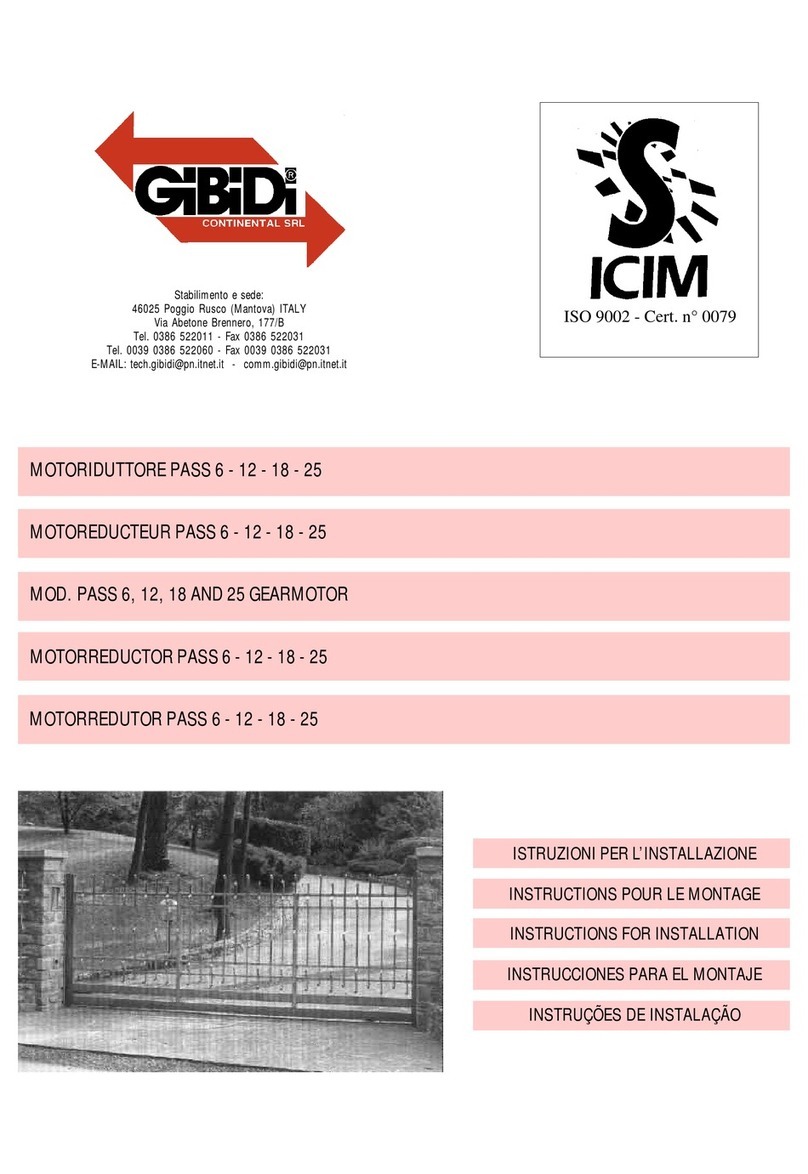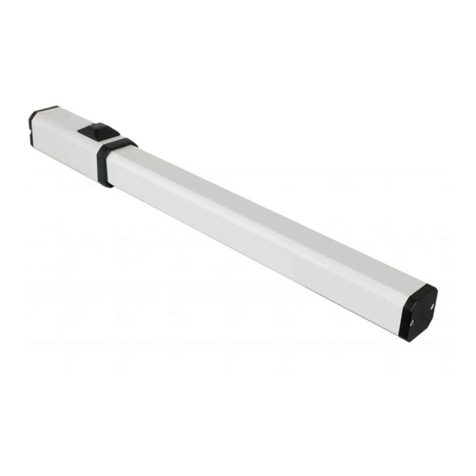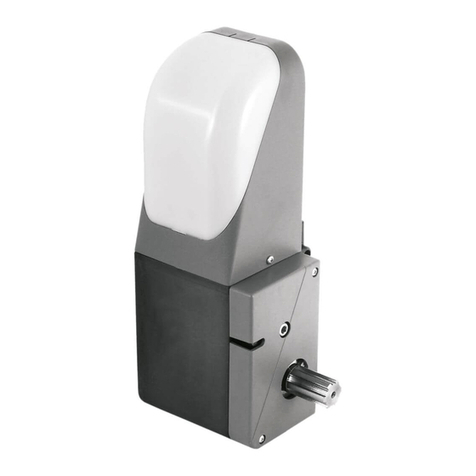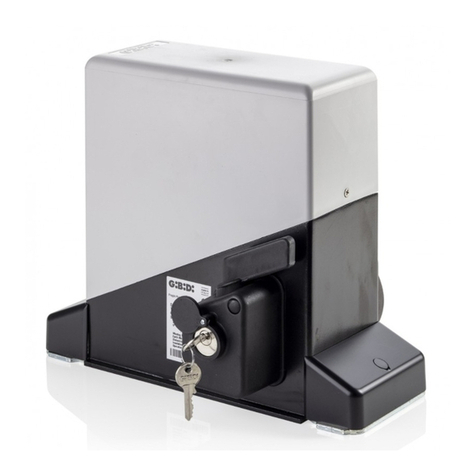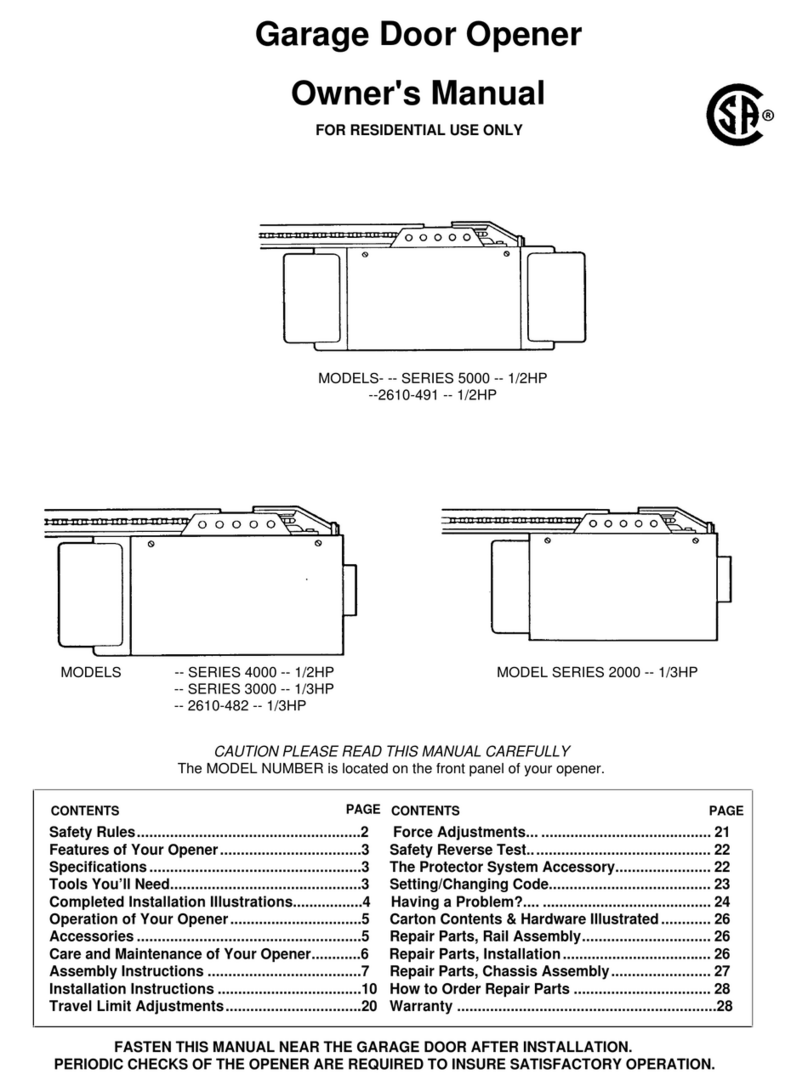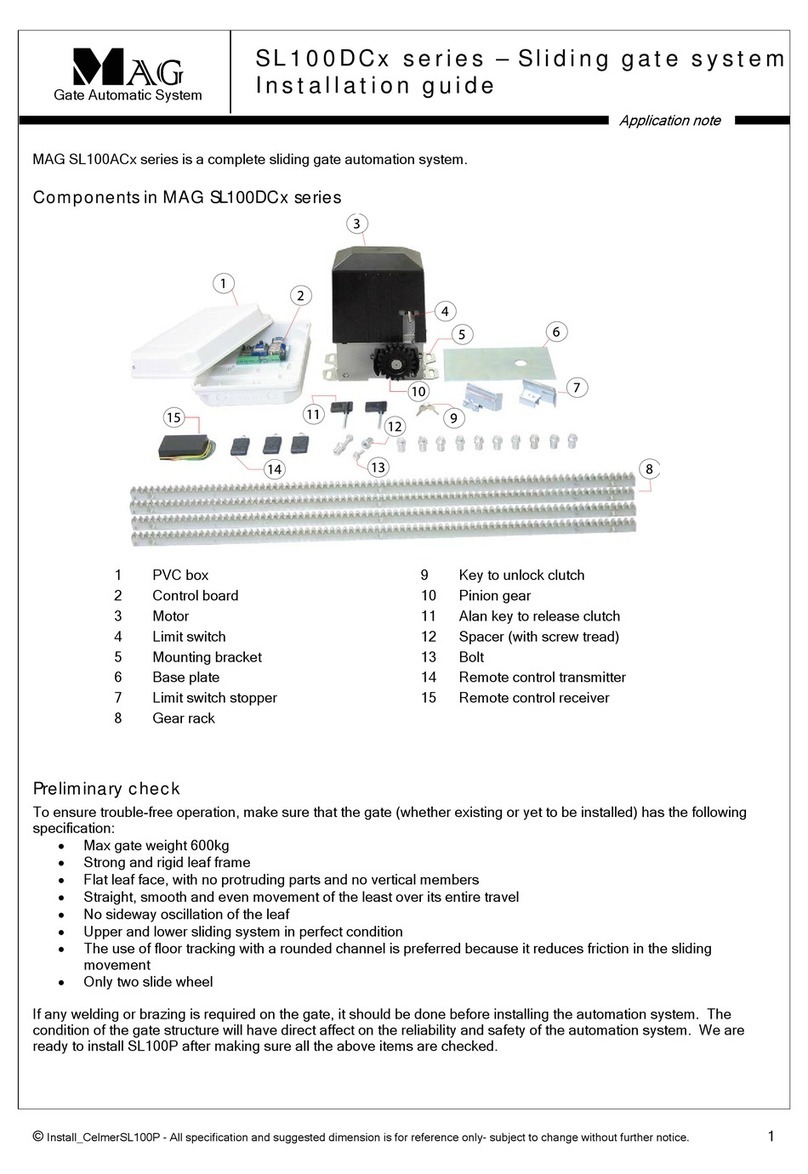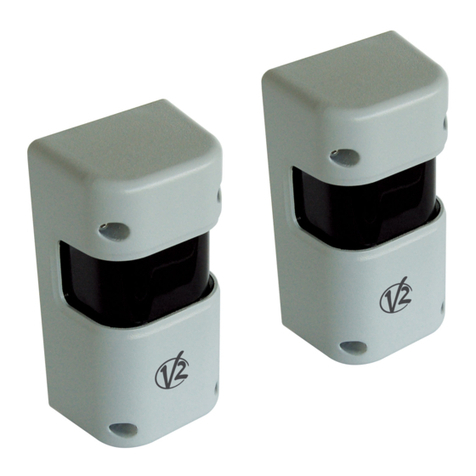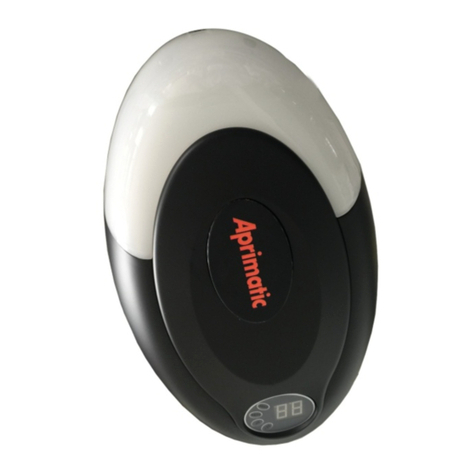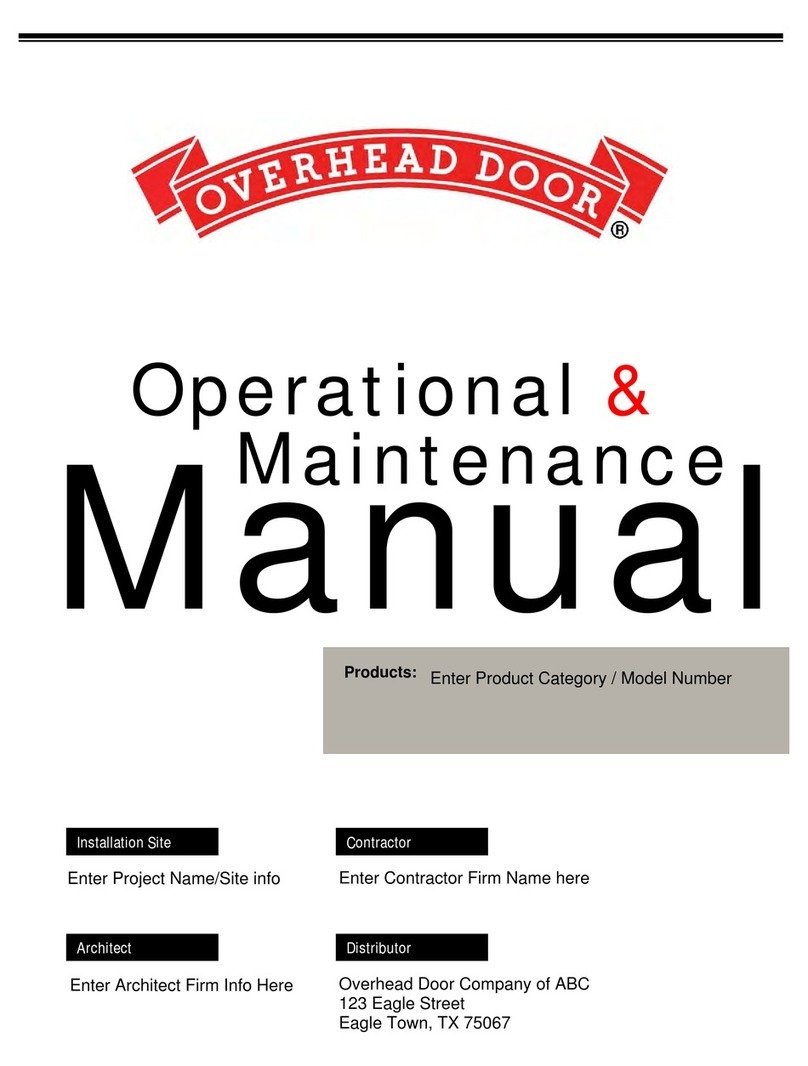GiBiDi CAPTIVE CAP T868 User manual

EN
CAP T868 / CAP T916
CAP ACTIVE
CAP R868 / CAP R916
CAP MAGIN
RadioBand3G System
USER MANUAL
CAPTIVE

Radio safety solution for industrial sliding gates with NO-TOUCH technology.
Based on 3 devices: • Transmitter (CAP T868/916, CAP ACTIVE 868),
• Receiver (CAP R868/916)
• Inhibition detector (CAP MAGIN).
•Suitable for all kind of metallic / aluminum sliding gates
• Category 2 devices.
CAP system is not suitable for wooden gates neither other non conductive materials
The safety edge device provides security degree. NO-TOUCH detection is a courtesy function.
The NO-TOUCH detection is not working all of the time, it only works when the gate is in motion. It detects
metal or conductive objects near the safety edge. It cannot detect plastics, glass or other non-conductive
materials.
The receiver manages the activation and deactivation of NO-TOUCH function depending on the status of the
inhibition detector (inhibition input).
Inhibition detector is based on magnetic fields thanks to the use of 2 polarized magnets (grey and black). These
2 magnets are responsible for activating and deactivating NO-TOUCH sensor on the transmitter. It is
necessary to deactivate NO-TOUCH sensor at a distance of 30-50cm before the door is totally closed (inhibition
zone).
The system complies with EN ISO 13849-1:2008, category 2, PLd. (when the auto-test function is used).
SAFETY EDGE CONNECTION
BATTERY CONNECTOR
Connect the batteries for operation
Do not carry the equipment with
batteries connected
LITHIUM BATTERIES
2X3,6Vdc ER14505
(Class 2 supply)
LEDS BS&NO-TOUCH safety edge state indicator
PROGRAMMING BUTTON
Program the transmitter to the receiver
GND. REFERENCE TAB
OPTION SELECTOR
(SENSITIVITY)
SENSITIVITY
Recomended
sensitivity range
adjustment
between 5-6
CLOSING GATE
INHIBITION ZONE
CAP ACTIVE
OR CAP T
CAP
MAGIN
COURTESY FUNCTION
SAFETY EDGE
MAGNET MAGNET
CAP R868
CAP ACTIVE
CAPTIVE
2CAPTIVE 3
EN EN
1 - INTRODUCTION
1.1 - GENERAL DESCRIPTION
LEDS
BS&NO-TOUCH safety edge
state indicator
BATTERY CONNECTOR
Connect the batteries for operation
Do nor carry the equipment with
batteries connected
PROGRAMMING BUTTON
Program the transmitter to the receiver
MIN.
SENS.
MAX.
SENS.
OPTION SELECTOR
(SENSITIVITY)
Indicates the NO-TOUCH
sensitivity range
LITHIUM BATTERIES
2 X 3,6Vdc ER14505 AA
(Class 2 supply)
SAFETY EDGE
MECHANICAL
NO-TOUCH
LED
D1
D2
Recommended
sensitivity range
adjustment
between 6-7
1.2 - CAP T868/916 TRANSMITTER
1.3 - CAP ACTIVE TRANSMITTER
LED INDICATOR
LED ON
SAFETY
EDGE
D1
D2 NO-TOUCH Deactivated
Normal
use
FLASHING OFF

Radio safety solution for industrial sliding gates with NO-TOUCH technology.
Based on 3 devices: • Transmitter (CAP T868/916, CAP ACTIVE 868),
• Receiver (CAP R868/916)
• Inhibition detector (CAP MAGIN).
•Suitable for all kind of metallic / aluminum sliding gates
• Category 2 devices.
CAP system is not suitable for wooden gates neither other non conductive materials
The safety edge device provides security degree. NO-TOUCH detection is a courtesy function.
The NO-TOUCH detection is not working all of the time, it only works when the gate is in motion. It detects
metal or conductive objects near the safety edge. It cannot detect plastics, glass or other non-conductive
materials.
The receiver manages the activation and deactivation of NO-TOUCH function depending on the status of the
inhibition detector (inhibition input).
Inhibition detector is based on magnetic fields thanks to the use of 2 polarized magnets (grey and black). These
2 magnets are responsible for activating and deactivating NO-TOUCH sensor on the transmitter. It is
necessary to deactivate NO-TOUCH sensor at a distance of 30-50cm before the door is totally closed (inhibition
zone).
The system complies with EN ISO 13849-1:2008, category 2, PLd. (when the auto-test function is used).
SAFETY EDGE CONNECTION
BATTERY CONNECTOR
Connect the batteries for operation
Do not carry the equipment with
batteries connected
LITHIUM BATTERIES
2X3,6Vdc ER14505
(Class 2 supply)
LEDS BS&NO-TOUCH safety edge state indicator
PROGRAMMING BUTTON
Program the transmitter to the receiver
GND. REFERENCE TAB
OPTION SELECTOR
(SENSITIVITY)
SENSITIVITY
Recomended
sensitivity range
adjustment
between 5-6
CLOSING GATE
INHIBITION ZONE
CAP ACTIVE
OR CAP T
CAP
MAGIN
COURTESY FUNCTION
SAFETY EDGE
MAGNET MAGNET
CAP R868
CAP ACTIVE
CAPTIVE
2CAPTIVE 3
EN EN
1 - INTRODUCTION
1.1 - GENERAL DESCRIPTION
LEDS
BS&NO-TOUCH safety edge
state indicator
BATTERY CONNECTOR
Connect the batteries for operation
Do nor carry the equipment with
batteries connected
PROGRAMMING BUTTON
Program the transmitter to the receiver
MIN.
SENS.
MAX.
SENS.
OPTION SELECTOR
(SENSITIVITY)
Indicates the NO-TOUCH
sensitivity range
LITHIUM BATTERIES
2 X 3,6Vdc ER14505 AA
(Class 2 supply)
SAFETY EDGE
MECHANICAL
NO-TOUCH
LED
D1
D2
Recommended
sensitivity range
adjustment
between 6-7
1.2 - CAP T868/916 TRANSMITTER
1.3 - CAP ACTIVE TRANSMITTER
LED INDICATOR
LED ON
SAFETY
EDGE
D1
D2 NO-TOUCH Deactivated
Normal
use
FLASHING OFF

4 5
1.4 - CAP R868/916 RECEIVER
1.5 - CAP MAGIN
green
green = INH
black = GND
red = 9 Vdc
red
= NO-TOUCH activated
= NO-TOUCH inhibited
GREY - BLACK magnets
position depends on the
direction of the gate.
CAP MAGIN LED must be GREEN
while gate is closing.
RED when gate is stopped.
MAGNETS
CAP MAGIN
DETECTOR
2m
GREY
BLACK
2 - DETECTION PRINCIPLES
CAP T detects objects near the safety edge of the gate by detecting variations between conductive part of the gate
and conductive parts of the safety edge.
For this reason CAP T has a cable to connect GND to the metal part of the gate.
It is very important for the correct function of the NO TOUCH detection that the ground reference tab is properly
connected to the gate.
The amount of detection/sensitivity is going to depend on:
• Size of the conductive part of the object.
• Distance from the object to the edge of the gate.
Maximum safety edge length = 2.5 m.
CAPTIVE CAPTIVE
EN EN
CHECK BUTTON
Verifies the proper
function of the system
LEDS
PROGRAMMING BUTTON
Memorise new transmitters
MR BRIDGE
Transmitters memory reset
ATEST INPUT
12/24V ac/dc 5mA input for testing system and/or
activation of safety edge (SW2)
(SW4)
INHIBITION INPUT
NO-TOUCH inhibition activation (SW3)
OPTIONS SELECTOR
12/24 VAC/DC
Input power supply
(9-35 Vdc, 8-28 Vac)
R1/R2 OUTPUTS
Relay outputs to inform
the control panel of the
safety edge status,
normally closed contact (CS)
and 8k2 (BS) for each relay
LED
R1
CHECK
R2
OFF
Normal
use
Safety edge in relay 1 activated or
not connected
Safety edge in relay 2 activated or
not connected
See signal coverage table
ON
SW FUNCTION ON
7s 30s
ON WORK
OFF
SW3 Inhibition Open contact Close contact
Functioning
mode
ATEST
polarity
Autocheck
period
SW1
SW2
SW4 12/24V
0V
12/24V
0V

4 5
1.4 - CAP R868/916 RECEIVER
1.5 - CAP MAGIN
green
green = INH
black = GND
red = 9 Vdc
red
= NO-TOUCH activated
= NO-TOUCH inhibited
GREY - BLACK magnets
position depends on the
direction of the gate.
CAP MAGIN LED must be GREEN
while gate is closing.
RED when gate is stopped.
MAGNETS
CAP MAGIN
DETECTOR
2m
GREY
BLACK
2 - DETECTION PRINCIPLES
CAP T detects objects near the safety edge of the gate by detecting variations between conductive part of the gate
and conductive parts of the safety edge.
For this reason CAP T has a cable to connect GND to the metal part of the gate.
It is very important for the correct function of the NO TOUCH detection that the ground reference tab is properly
connected to the gate.
The amount of detection/sensitivity is going to depend on:
• Size of the conductive part of the object.
• Distance from the object to the edge of the gate.
Maximum safety edge length = 2.5 m.
CAPTIVE CAPTIVE
EN EN
CHECK BUTTON
Verifies the proper
function of the system
LEDS
PROGRAMMING BUTTON
Memorise new transmitters
MR BRIDGE
Transmitters memory reset
ATEST INPUT
12/24V ac/dc 5mA input for testing system and/or
activation of safety edge (SW2)
(SW4)
INHIBITION INPUT
NO-TOUCH inhibition activation (SW3)
OPTIONS SELECTOR
12/24 VAC/DC
Input power supply
(9-35 Vdc, 8-28 Vac)
R1/R2 OUTPUTS
Relay outputs to inform
the control panel of the
safety edge status,
normally closed contact (CS)
and 8k2 (BS) for each relay
LED
R1
CHECK
R2
OFF
Normal
use
Safety edge in relay 1 activated or
not connected
Safety edge in relay 2 activated or
not connected
See signal coverage table
ON
SW FUNCTION ON
7s 30s
ON WORK
OFF
SW3 Inhibition Open contact Close contact
Functioning
mode
ATEST
polarity
Autocheck
period
SW1
SW2
SW4 12/24V
0V
12/24V
0V

To avoid false detections and ensure a
longer NO TOUCH range, the gap between
the “internal wires” and the gate must be
as big as possible.
GROUND cable must be
connected to the metallic part
of the gate.
Safety edge wire
must be as short
as possible to
avoid vibrations.
MAGNET
INHIBITION ZONE
IMPORTANT
CAP
MAGIN
CAP ACTIVE
OR CAP T
CAP R868
MAGNET
CLOSING GATE
Do not place
metal surfaces
between transmitter
and receiver.
6 7
3 - INSTALLATION
3.1 - CAP T/CAP R
3.2 - CAP ACTIVE
RECEIVER TRANSMITTER
AVOIDING EXCESSIVE VIBRATION IS A MUST.
Use safety edges where conductor cannot be moved easily by the movement of the gate.
Use metallic profiles appropriated for the safety edge used.
Non disporre le
superfici di metallo
tra il trasmettitore
e il ricevitore.
Fix the clip to the
column or to the gate
as set out in
(h/4 h/2 / h-h/4)
Fix the edge to the
CLIP in the column
or to the gate, and
secure with screws,
see (k/j).
CAP ACTIVE safety
edge must be
positioned vertically,
taking care to mount
the card with the board
in the upper part.
Ground cable must be
fixed to the gate.
Make sure that ground and
antenna wires are NOT in
contact.
Remove the
locking pin (1c)
NOTE: in order to improve
the discharge of any sediment
that may be found inside
the bottom cap, it is advisable
to drill a hole, as shown in (1d)
Ø 5mm
3.2.1 CABLE TENSIONING AND CALIBRATION
Optimum operation
of the device is
achieved, with
the electrical
intervention,
with a deformation
at the centre of the
safety edge equal
to about 20 mm.
The safety edge is
already provided with
pretensioned cable.
However, you can make
further adjustment by
turning the SCREW on
the arm of the upper
support of the edge.
- Turning clockwise will
increase the sensitivity
of the edge (+)
- Turning counterclockwise
will decrease the sensitivity
of the edge (-)
CAPTIVE CAPTIVE
EN EN

To avoid false detections and ensure a
longer NO TOUCH range, the gap between
the “internal wires” and the gate must be
as big as possible.
GROUND cable must be
connected to the metallic part
of the gate.
Safety edge wire
must be as short
as possible to
avoid vibrations.
MAGNET
INHIBITION ZONE
IMPORTANT
CAP
MAGIN
CAP ACTIVE
OR CAP T
CAP R868
MAGNET
CLOSING GATE
Do not place
metal surfaces
between transmitter
and receiver.
6 7
3 - INSTALLATION
3.1 - CAP T/CAP R
3.2 - CAP ACTIVE
RECEIVER TRANSMITTER
AVOIDING EXCESSIVE VIBRATION IS A MUST.
Use safety edges where conductor cannot be moved easily by the movement of the gate.
Use metallic profiles appropriated for the safety edge used.
Non disporre le
superfici di metallo
tra il trasmettitore
e il ricevitore.
Fix the clip to the
column or to the gate
as set out in
(h/4 h/2 / h-h/4)
Fix the edge to the
CLIP in the column
or to the gate, and
secure with screws,
see (k/j).
CAP ACTIVE safety
edge must be
positioned vertically,
taking care to mount
the card with the board
in the upper part.
Ground cable must be
fixed to the gate.
Make sure that ground and
antenna wires are NOT in
contact.
Remove the
locking pin (1c)
NOTE: in order to improve
the discharge of any sediment
that may be found inside
the bottom cap, it is advisable
to drill a hole, as shown in (1d)
Ø 5mm
3.2.1 CABLE TENSIONING AND CALIBRATION
Optimum operation
of the device is
achieved, with
the electrical
intervention,
with a deformation
at the centre of the
safety edge equal
to about 20 mm.
The safety edge is
already provided with
pretensioned cable.
However, you can make
further adjustment by
turning the SCREW on
the arm of the upper
support of the edge.
- Turning clockwise will
increase the sensitivity
of the edge (+)
- Turning counterclockwise
will decrease the sensitivity
of the edge (-)
CAPTIVE CAPTIVE
EN EN

CLOSING GATE
Gate must be
TOTALLY OPEN
to fix the grey magnet.
CAP ACTIVE
CAP T
CAP
MAGIN
SUPPORT
INHIBITION ZONE: NO TOUCH
30-50 CM
8 9
3.2.2 POSITIONING OF THE COVER
3.2.3 POWER SUPPLY
BATTERY CONNECTOR
Connect the batteries for operation.
Do not carry the equipment with
batteries connected.
3.3 - CAP MAGIN
SUPPORT
MAGIN
1-2 cm
MAGNET
GATE
MAGNETS: at the gate.
The Grey magnet should be installed to activate the NO-TOUCH sensor when the gate starts the closing movement.
The Black magnet switches off the NO-TOUCH sensor in order to allow the gate to close fully.
CAP MAGIN: install onto a support near the magnets and at the
same height
GREY – BLACK magnets position depends on the direction of the gate.
CAP MAGIN LED must be GREEN while gate is closing/opening, RED when
gate is totally closed/open.
Depending on the gate direction, BLACK magnet
is the one which de-activates the NO-TOUCH.
Before fixing the magnet, CAP ACTIVE/CAP T
must be programmed at the receiver.
The location of the black magnet indicates the
inhibition zone at closing.
In case the gate is not totally opened/closed, a safety time of 5
minutes is added to avoid battery consumption.
Maximum NO TOUCH activation time = 5 minutes
To insert the soft cap, place it in front of the support plate, taking
care to slide the flaps in their seats (3a) and the two lateral locking
hooks inside of slits arranged (3b).
Apply a light pressure so that there is a click to indicate the correct
placement of the same
Secure the cover with the screw provided.
To remove the cover reverse the procedure: remove the screw
(3c), release the cap by inserting a tool inside the slits pushing
the hooks inward.
3.3.1 FIXING THE ACTIVATION MAGNET
3.3.2 FIXING THE DEACTIVATION MAGNET
GREY
BLACK
With the GATE TOTALLY OPEN fix the south field magnet (Grey).
The Grey magnet must be 2-3 cm away from the MAGIN detector. When the gate starts closing, the Grey magnet
travels past the MAGIN and NO-TOUCH gate sensor is activated.
LED indicator on MAGIN detector changes to green color when Grey magnet passes in front of MAGIN.
With the GATE AT 30-50 cm FROM ITS CLOSED POSITION:
The Black magnet must be fixed at the other extreme of the gate (in respect of the grey magnet). The location of
this magnet depends on the inhibition zone desired.
Due to NO TOUCH detection, it is required that an INHIBITION ZONE is created at the end of the gate movement in
order to avoid the detection of the wall support by NO TOUCH detector. In this zone, the safety edge will only be
activated from normal mechanical compression.
Inhibition zone length depends on NO TOUCH sensitivity adjustment.
When NO-TOUCH sensor is detecting, an LED on the transmitter is activated. If the indicators on the transmitter
are switched off, it will be necessary to press the PROG button on the transmitter to activate, for 5 minutes,
the LED function.
The LED indicator on MAGIN detector changes to a red color when black magnet passes in front of the MAGIN.
CAPTIVE CAPTIVE
EN EN
Before fixing the black magnet, CAP ACTIVE/CAP T
must be programmed at the receiver.

CLOSING GATE
Gate must be
TOTALLY OPEN
to fix the grey magnet.
CAP ACTIVE
CAP T
CAP
MAGIN
SUPPORT
INHIBITION ZONE: NO TOUCH
30-50 CM
8 9
3.2.2 POSITIONING OF THE COVER
3.2.3 POWER SUPPLY
BATTERY CONNECTOR
Connect the batteries for operation.
Do not carry the equipment with
batteries connected.
3.3 - CAP MAGIN
SUPPORT
MAGIN
1-2 cm
MAGNET
GATE
MAGNETS: at the gate.
The Grey magnet should be installed to activate the NO-TOUCH sensor when the gate starts the closing movement.
The Black magnet switches off the NO-TOUCH sensor in order to allow the gate to close fully.
CAP MAGIN: install onto a support near the magnets and at the
same height
GREY – BLACK magnets position depends on the direction of the gate.
CAP MAGIN LED must be GREEN while gate is closing/opening, RED when
gate is totally closed/open.
Depending on the gate direction, BLACK magnet
is the one which de-activates the NO-TOUCH.
Before fixing the magnet, CAP ACTIVE/CAP T
must be programmed at the receiver.
The location of the black magnet indicates the
inhibition zone at closing.
In case the gate is not totally opened/closed, a safety time of 5
minutes is added to avoid battery consumption.
Maximum NO TOUCH activation time = 5 minutes
To insert the soft cap, place it in front of the support plate, taking
care to slide the flaps in their seats (3a) and the two lateral locking
hooks inside of slits arranged (3b).
Apply a light pressure so that there is a click to indicate the correct
placement of the same
Secure the cover with the screw provided.
To remove the cover reverse the procedure: remove the screw
(3c), release the cap by inserting a tool inside the slits pushing
the hooks inward.
3.3.1 FIXING THE ACTIVATION MAGNET
3.3.2 FIXING THE DEACTIVATION MAGNET
GREY
BLACK
With the GATE TOTALLY OPEN fix the south field magnet (Grey).
The Grey magnet must be 2-3 cm away from the MAGIN detector. When the gate starts closing, the Grey magnet
travels past the MAGIN and NO-TOUCH gate sensor is activated.
LED indicator on MAGIN detector changes to green color when Grey magnet passes in front of MAGIN.
With the GATE AT 30-50 cm FROM ITS CLOSED POSITION:
The Black magnet must be fixed at the other extreme of the gate (in respect of the grey magnet). The location of
this magnet depends on the inhibition zone desired.
Due to NO TOUCH detection, it is required that an INHIBITION ZONE is created at the end of the gate movement in
order to avoid the detection of the wall support by NO TOUCH detector. In this zone, the safety edge will only be
activated from normal mechanical compression.
Inhibition zone length depends on NO TOUCH sensitivity adjustment.
When NO-TOUCH sensor is detecting, an LED on the transmitter is activated. If the indicators on the transmitter
are switched off, it will be necessary to press the PROG button on the transmitter to activate, for 5 minutes,
the LED function.
The LED indicator on MAGIN detector changes to a red color when black magnet passes in front of the MAGIN.
CAPTIVE CAPTIVE
EN EN
Before fixing the black magnet, CAP ACTIVE/CAP T
must be programmed at the receiver.

ON MODE
ATEST
SAFETY
STATE
ON
CAP R
Receiver output
CAP R
Receiver output
Optical safety
edge
power supply
ATEST
WORK MODE
SW4 at OFF SW4 at OFF
Positive polarity
ATEST > 150ms ATEST > 300ms
Ton
ATEST
Ton
safety state Ton
ATEST
Ton
safety state
Safety activated
OK NOT OK OK
ONOFF
GATE CONTROL PANEL
10 11
4 - CONNECTIONS
4.1 - CONNECTING THE CAP T (safety edge)
4.3 - CONNECTING THE RECEIVER TO THE CONTROL PANEL
8k2 RESISTIVE SAFETY EDGE
Supports 8k2/10k
resistive safety edges.
8k2/10k
INHibition input (N.O.) on the transmitter
works in the same way as inhibition input
on the receiver.
A closing signal in INH switches off the
NO-TOUCH sensor.
Ground cable must be fixed to the gate.
Make sure that ground and antenna wires
are NOT in contact.
Connecting the safety outputs to gate control panel:
The equipment can be connected to the gate control panel to any input for safety edge 8k2 or directly into a safety
input normally closed contact as if it were a photocell or stop signal.
This connectivity exists for R1 and R2 outputs.
In order to comply with EN ISO 13849-1: 2008 safety standard, a signal to test the system must be connected.
EXAMPLE: connection to gate control panel with safety contact / STOP input
EXAMPLE: connection to gate control panel with input for safety edge 8k2
Check the ground wire is properly fixed and the cable
tension is calibrated.
Any kind of external signal is suitable to manage the activation / deactivation of the NO TOUCH function. A dry
contact signal must be connected into INH – GND terminal. Selector 3 on the receiver selects the inhibition signal
polarity (NO or NC) to be able to apply different kind of signals.
When INH LED on the receiver is switched on, the NO TOUCH sensor is deactivated.
When working with optical safety edges, in ON mode, only OSE-S7502 are allowed as they remain always active.
The radio communication is tested every 7 or 30 seconds depending on the selector SW1 of the receiver.
In WORK mode, the ATEST signal is used to power up and down the optical safety edges. The radio communication
is tested as in ON mode and when the optical elements are powered up and down.
Safety edge status R1
status
R1
LED
Safety edge activated or
not programmed
Safety edge OK Close OFF
Open ON
CONTROL PANEL
Safety edge status R1
status
R1
LED
Safety edge activated or
not programmed
Safety edge OK OFF
ON
GATE CONTROL PANEL
4.2 - CONNECTING THE CAP ACTIVE (safety edge)
4.4 - CONNECTING MAGIN TO THE RECEIVER
CAPTIVE CAPTIVE
EN EN

ON MODE
ATEST
SAFETY
STATE
ON
CAP R
Receiver output
CAP R
Receiver output
Optical safety
edge
power supply
ATEST
WORK MODE
SW4 at OFF SW4 at OFF
Positive polarity
ATEST > 150ms ATEST > 300ms
Ton
ATEST
Ton
safety state Ton
ATEST
Ton
safety state
Safety activated
OK NOT OK OK
ONOFF
GATE CONTROL PANEL
10 11
4 - CONNECTIONS
4.1 - CONNECTING THE CAP T (safety edge)
4.3 - CONNECTING THE RECEIVER TO THE CONTROL PANEL
8k2 RESISTIVE SAFETY EDGE
Supports 8k2/10k
resistive safety edges.
8k2/10k
INHibition input (N.O.) on the transmitter
works in the same way as inhibition input
on the receiver.
A closing signal in INH switches off the
NO-TOUCH sensor.
Ground cable must be fixed to the gate.
Make sure that ground and antenna wires
are NOT in contact.
Connecting the safety outputs to gate control panel:
The equipment can be connected to the gate control panel to any input for safety edge 8k2 or directly into a safety
input normally closed contact as if it were a photocell or stop signal.
This connectivity exists for R1 and R2 outputs.
In order to comply with EN ISO 13849-1: 2008 safety standard, a signal to test the system must be connected.
EXAMPLE: connection to gate control panel with safety contact / STOP input
EXAMPLE: connection to gate control panel with input for safety edge 8k2
Check the ground wire is properly fixed and the cable
tension is calibrated.
Any kind of external signal is suitable to manage the activation / deactivation of the NO TOUCH function. A dry
contact signal must be connected into INH – GND terminal. Selector 3 on the receiver selects the inhibition signal
polarity (NO or NC) to be able to apply different kind of signals.
When INH LED on the receiver is switched on, the NO TOUCH sensor is deactivated.
When working with optical safety edges, in ON mode, only OSE-S7502 are allowed as they remain always active.
The radio communication is tested every 7 or 30 seconds depending on the selector SW1 of the receiver.
In WORK mode, the ATEST signal is used to power up and down the optical safety edges. The radio communication
is tested as in ON mode and when the optical elements are powered up and down.
Safety edge status R1
status
R1
LED
Safety edge activated or
not programmed
Safety edge OK Close OFF
Open ON
CONTROL PANEL
Safety edge status R1
status
R1
LED
Safety edge activated or
not programmed
Safety edge OK OFF
ON
GATE CONTROL PANEL
4.2 - CONNECTING THE CAP ACTIVE (safety edge)
4.4 - CONNECTING MAGIN TO THE RECEIVER
CAPTIVE CAPTIVE
EN EN

12 13
5 - ADJUSTMENT OF THE RECIVER / OPERATING MODES
AUTOCHECK PERIOD
OPERATING MODE WITH OPTICAL SAFETY EDGES
ATEST SIGNAL POLARITY (depends on the control panel)
INHIBITION POLARITY
SW1
SW2
SW4
SW3
7 s
ON
Negative
30 s
WORK
Positive
Close
contact
Open
contact
The system performs a complete test of the equipment, including
radio communication.
In ON mode, only "always on" optical safety edges (OSE-S7502) are
permitted, as the optical element always is on.
In WORK mode, the optical elements are OFF meanwhile the ATEST
signal is active. So it is necessary to disconnect this ATEST signal
during the gate movement.
ATEST negative: ATEST signal is a fixed 12 or 24V signal that the
control panel sets to 0V to make the system check.
ATEST positive: ATEST signal is disconnected and when the control
panel makes a test it provides a 12 or 24V signal.
Open contact in “INH-GND” connector switches off NO TOUCH
detector.
Close contact in “INH-GND” connector switches off NO TOUCH
detector (CAP MAGIN)
CAP R868/916 receiver can work with standard RB3 transmitters and new CAP ACTIVE/CAP T transmitter
(NO-TOUCH function) at the same time.
Inhibition input (switch on and off the NO-TOUCH function) will affect all CAP ACTIVE/CAP T transmitters
in the same way. It does not make any difference between safety edge on opening nor on closing.
CAP ACTIVE / CAP T transmitter has 2 separate detectors, mechanical / resistive safety edge and NO-TOUCH
function. Both program together and at the same time as if they were a single safety edge on the receiver. It is
necessary to see the LED indicators on CAP ACTIVE / CAP T to know which kind of technology is either detecting
a collision (safety edge) or prevent the collision (NO-TOUCH function)
In the case of operating without ATEST signal, it is necessary to work with ATEST set to positive. In order to comply
with the EN ISO 13849-1: 2008 safety standard, you must connect this signal to test the system.
ON/WORK mode
The operating mode is selected by the SW2 of the receiver. This selector is necessary when working with optical
safety edges. All transmitters in the receiver work in the same way. It will be necessary to reset the receiver when
changing the operating mode with transmitters already memorised.
With standard optical safety edges, WORK mode must be used due to high consumption of the optical elements.
With OSE-S7502 "always on" optical safety edges, both modes are allowed. In ON mode, the system becomes
universal for any control panel. In WORK mode the battery life is maximized thanks to the shutdown of the optical
elements.
Before programming, place the options selectors at the
desired position. Any subsequent change will require a
receiver reset and reprogramming.
Press the PROG button on receiver and hold it until the
desired mode is selected. LED's for R1 & R2 will light up or
flash in sequence to select the correct operation mode.
There are four programming modes, depending on the
inputs you wish to use of the transmitter and the outputs
required to activate on the receiver.
The receiver allows the programming 6 safety edges
(3 for Relay 1 and 3 for Relay 2). A safety edge can only
be programmed to one receiver.
6 - PROGRAMMING
6.1 - PROGRAMMING SAFETY EDGE TO RECEIVER
CAPTIVE CAPTIVE
MODES
1
2
3
IN1
Safety edge in IN1 on transmitter activates R1 on receiver
IN1
Safety edge in IN1 on transmitter activates R2 on receiver
IN1
Safety edge in IN1 on transmitter activates R1 and R2 on receiver
R2:
R1+R2:
R1
4
In case of CAP ACTIVE/CAP T, safety edge is IN1 and
NO TOUCH function is IN2
EN EN
Safety edge in IN1 on transmitter activates R1 on receiver
and Safety edge in IN2 on transmitter activates R2 on receiver
R1 and IN2 R2:
IN1

12 13
5 - ADJUSTMENT OF THE RECIVER / OPERATING MODES
AUTOCHECK PERIOD
OPERATING MODE WITH OPTICAL SAFETY EDGES
ATEST SIGNAL POLARITY (depends on the control panel)
INHIBITION POLARITY
SW1
SW2
SW4
SW3
7 s
ON
Negative
30 s
WORK
Positive
Close
contact
Open
contact
The system performs a complete test of the equipment, including
radio communication.
In ON mode, only "always on" optical safety edges (OSE-S7502) are
permitted, as the optical element always is on.
In WORK mode, the optical elements are OFF meanwhile the ATEST
signal is active. So it is necessary to disconnect this ATEST signal
during the gate movement.
ATEST negative: ATEST signal is a fixed 12 or 24V signal that the
control panel sets to 0V to make the system check.
ATEST positive: ATEST signal is disconnected and when the control
panel makes a test it provides a 12 or 24V signal.
Open contact in “INH-GND” connector switches off NO TOUCH
detector.
Close contact in “INH-GND” connector switches off NO TOUCH
detector (CAP MAGIN)
CAP R868/916 receiver can work with standard RB3 transmitters and new CAP ACTIVE/CAP T transmitter
(NO-TOUCH function) at the same time.
Inhibition input (switch on and off the NO-TOUCH function) will affect all CAP ACTIVE/CAP T transmitters
in the same way. It does not make any difference between safety edge on opening nor on closing.
CAP ACTIVE / CAP T transmitter has 2 separate detectors, mechanical / resistive safety edge and NO-TOUCH
function. Both program together and at the same time as if they were a single safety edge on the receiver. It is
necessary to see the LED indicators on CAP ACTIVE / CAP T to know which kind of technology is either detecting
a collision (safety edge) or prevent the collision (NO-TOUCH function)
In the case of operating without ATEST signal, it is necessary to work with ATEST set to positive. In order to comply
with the EN ISO 13849-1: 2008 safety standard, you must connect this signal to test the system.
ON/WORK mode
The operating mode is selected by the SW2 of the receiver. This selector is necessary when working with optical
safety edges. All transmitters in the receiver work in the same way. It will be necessary to reset the receiver when
changing the operating mode with transmitters already memorised.
With standard optical safety edges, WORK mode must be used due to high consumption of the optical elements.
With OSE-S7502 "always on" optical safety edges, both modes are allowed. In ON mode, the system becomes
universal for any control panel. In WORK mode the battery life is maximized thanks to the shutdown of the optical
elements.
Before programming, place the options selectors at the
desired position. Any subsequent change will require a
receiver reset and reprogramming.
Press the PROG button on receiver and hold it until the
desired mode is selected. LED's for R1 & R2 will light up or
flash in sequence to select the correct operation mode.
There are four programming modes, depending on the
inputs you wish to use of the transmitter and the outputs
required to activate on the receiver.
The receiver allows the programming 6 safety edges
(3 for Relay 1 and 3 for Relay 2). A safety edge can only
be programmed to one receiver.
6 - PROGRAMMING
6.1 - PROGRAMMING SAFETY EDGE TO RECEIVER
CAPTIVE CAPTIVE
MODES
1
2
3
IN1
Safety edge in IN1 on transmitter activates R1 on receiver
IN1
Safety edge in IN1 on transmitter activates R2 on receiver
IN1
Safety edge in IN1 on transmitter activates R1 and R2 on receiver
R2:
R1+R2:
R1
4
In case of CAP ACTIVE/CAP T, safety edge is IN1 and
NO TOUCH function is IN2
EN EN
Safety edge in IN1 on transmitter activates R1 on receiver
and Safety edge in IN2 on transmitter activates R2 on receiver
R1 and IN2 R2:
IN1

RECEIVER
TRANSMITTER
14 15
CAPTIVE CAPTIVE
6.1.1 MODE 1: SAFETY EDGE CONNECTED TO IN1 ACTIVATES R1 6.1.3 MODE 3: SAFETY EDGE CONNECTED TO IN1 ACTIVATES R1 AND R2
6.1.2 MODE 2: SAFETY EDGE CONNECTED TO IN1 ACTIVATES R2
EN EN
RECEIVER
TRANSMITTER
Safety edge connected in IN1 will activate R1.
Receiver memory used = 1 transmitter.
Programming sequence:
• Press PROG button on the receiver (1) until R1 LED lights up (2).
• Press PROG button on the transmitter (3).
• A beep will be heard on the receiver indicating the transmitter is properly programmed (4).
To exit programming mode, wait for 10 seconds or press PROG button on the receiver. Two beeps will be heard.
Safety edge connected in IN1 will activate R2.
Receiver memory used = 1 transmitter.
P
• Press PROG button on the receiver (1) until R2 LED lights up (2).
• Press PROG button on the transmitter (3).
• A beep will be heard on the receiver indicating the transmitter is properly programmed (4).
To exit programming mode, wait for 10 seconds or press PROG button on the receiver. Two beeps will be heard.
rogramming sequence:
RECEIVER
TRANSMITTER
RECEIVER
TRANSMITTER
Safety edge connected in IN1 will activate R1 and R2.
Receiver memory used = 2 transmitters.
Programming sequence
• Press PROG button on the receiver (1) until R1 and R2 LEDs light up (2).
• Press PROG button on the transmitter (3).
• A beep will be heard on the receiver indicating the transmitter is properly programmed (4).
To exit programming mode, wait for 10 seconds or press PROG button on the receiver. Two beeps will be heard.
:
6.3.4 MODE 4: SAFETY EDGE CONNECTED TO IN1 ACTIVATES R1
AND SAFETY EDGE CONNECTED TO IN2 ACTIVATES R2
Safety edge connected in IN1 will activate R1 and IN2 will activate R2.
Receiver memory used = 2 transmitters.
Programming sequence
• Press PROG button on the receiver (1) until R1 LED
and R2 LED begin to flash (2).
• Press PROG button on the transmitter (3).
• A beep will be heard on the receiver indicating the transmitter is properly programmed (4).
To exit programming mode, wait for 10 seconds or press PROG button on the receiver. Two beeps will be heard.
:

RECEIVER
TRANSMITTER
14 15
CAPTIVE CAPTIVE
6.1.1 MODE 1: SAFETY EDGE CONNECTED TO IN1 ACTIVATES R1 6.1.3 MODE 3: SAFETY EDGE CONNECTED TO IN1 ACTIVATES R1 AND R2
6.1.2 MODE 2: SAFETY EDGE CONNECTED TO IN1 ACTIVATES R2
EN EN
RECEIVER
TRANSMITTER
Safety edge connected in IN1 will activate R1.
Receiver memory used = 1 transmitter.
Programming sequence:
• Press PROG button on the receiver (1) until R1 LED lights up (2).
• Press PROG button on the transmitter (3).
• A beep will be heard on the receiver indicating the transmitter is properly programmed (4).
To exit programming mode, wait for 10 seconds or press PROG button on the receiver. Two beeps will be heard.
Safety edge connected in IN1 will activate R2.
Receiver memory used = 1 transmitter.
P
• Press PROG button on the receiver (1) until R2 LED lights up (2).
• Press PROG button on the transmitter (3).
• A beep will be heard on the receiver indicating the transmitter is properly programmed (4).
To exit programming mode, wait for 10 seconds or press PROG button on the receiver. Two beeps will be heard.
rogramming sequence:
RECEIVER
TRANSMITTER
RECEIVER
TRANSMITTER
Safety edge connected in IN1 will activate R1 and R2.
Receiver memory used = 2 transmitters.
Programming sequence
• Press PROG button on the receiver (1) until R1 and R2 LEDs light up (2).
• Press PROG button on the transmitter (3).
• A beep will be heard on the receiver indicating the transmitter is properly programmed (4).
To exit programming mode, wait for 10 seconds or press PROG button on the receiver. Two beeps will be heard.
:
6.3.4 MODE 4: SAFETY EDGE CONNECTED TO IN1 ACTIVATES R1
AND SAFETY EDGE CONNECTED TO IN2 ACTIVATES R2
Safety edge connected in IN1 will activate R1 and IN2 will activate R2.
Receiver memory used = 2 transmitters.
Programming sequence
• Press PROG button on the receiver (1) until R1 LED
and R2 LED begin to flash (2).
• Press PROG button on the transmitter (3).
• A beep will be heard on the receiver indicating the transmitter is properly programmed (4).
To exit programming mode, wait for 10 seconds or press PROG button on the receiver. Two beeps will be heard.
:

16 17
CAPTIVE CAPTIVE
7 - CHANGING SIZE OF THE SAFETY EDGE
7.1 - REMOVING SAFETY EDGE
7.3 - SAFETY EDGE INSTALLATION
7.2 - CHANGING SIZES
Insert the supplied locking pin to uspend the movement
of the cam (a)
Withdraw the rubber
from the aluminium bar
Remove the upper
support from the
aluminium profile
Remove the cable
from the joint
to the lower support
of the edge
ATTENTION:
do not loosen the
locking screw that
locks the cable
from the cam
Unscrew the locking screw (b)
that locks the cable coming out
from the lower part of the edge
Slide the rubber in the aluminium profile(g)
When you have finished, the
rubber edge should over-
hang over 20mm compared
to the aluminium profile (i)
Keeping tension on the steel cable,
clamp the locking screw in this joint (l)
Remove the
locking pin (m)
Proceed to the “Cable tension and calibration” according to point 3.2.1
Proceed to the “Positioning of the cap” according to point 3.2.2
Push the cable into
the joint (k) taking it
through the oblique
hole
Reassembe the steel
cable through the
cable conduit housed
in the rubber edge (j)
Reassemble the upper support
in the aluminium profile (h)
1
2
3
EN EN
EXAMPLE to get an edge of: MBS = 1800 mm
Extruded rubber: MBS mm -245 mm (cut) = 1555 mm
Aluminium profile: MBS mm -285 mm (cut) = 1515 mm

16 17
CAPTIVE CAPTIVE
7 - CHANGING SIZE OF THE SAFETY EDGE
7.1 - REMOVING SAFETY EDGE
7.3 - SAFETY EDGE INSTALLATION
7.2 - CHANGING SIZES
Insert the supplied locking pin to uspend the movement
of the cam (a)
Withdraw the rubber
from the aluminium bar
Remove the upper
support from the
aluminium profile
Remove the cable
from the joint
to the lower support
of the edge
ATTENTION:
do not loosen the
locking screw that
locks the cable
from the cam
Unscrew the locking screw (b)
that locks the cable coming out
from the lower part of the edge
Slide the rubber in the aluminium profile(g)
When you have finished, the
rubber edge should over-
hang over 20mm compared
to the aluminium profile (i)
Keeping tension on the steel cable,
clamp the locking screw in this joint (l)
Remove the
locking pin (m)
Proceed to the “Cable tension and calibration” according to point 3.2.1
Proceed to the “Positioning of the cap” according to point 3.2.2
Push the cable into
the joint (k) taking it
through the oblique
hole
Reassembe the steel
cable through the
cable conduit housed
in the rubber edge (j)
Reassemble the upper support
in the aluminium profile (h)
1
2
3
EN EN
EXAMPLE to get an edge of: MBS = 1800 mm
Extruded rubber: MBS mm -245 mm (cut) = 1555 mm
Aluminium profile: MBS mm -285 mm (cut) = 1515 mm

18 19
CAPTIVE CAPTIVE
8 - CHECKING AND MAINTENANCE
8.1 - DOES THE EQUIPMENT WORK PROPERLY?
8.2 - CHECK THE CORRECT OPERATION
8.3 - CHECK FUNCTION
8.4 - TROUBLESHOOTING
Once the safety edge is wired and programmed into the receiver, R1 and / or R2 (according to programming mode)
are not illuminated (OFF). Also IN1 and IN2 LEDS at the transmitter are at OFF.
If the safety edge has been programmed in R1 and R1 LED is at ON, check that the safety edge is not
pushed/detecting (IN1 LED at ON on the transmitter) or it is not properly configured (IN1 LED flashing on the
transmitter). If IN1 LED is at OFF and R1 LED is at ON, check status of other transmitters memorised.
The IN1 and IN2 LEDs of the transmitter will switch to battery saving mode (off) 5 minutes after pressing PROG on
the transmitter. They can re-awaken again pressing the PROG button on the transmitter.
If there is no safety edge programmed in R1 and/or R2, then safety mode will be operational (opened and LED
at ON).
If R1 / R2 LEDs are OFF, but the gate does not move, check that the wiring to the control panel is made correctly
as safety contact or resistive safety edge input.
Check also if LED indicator on MAGIN detector changes to red color in the desired inhibition zone, and the INH LED
on the receiver is switched ON.
Press the safety edge to assure that the appropriate relay on the receiver is activated.
If not, see the Troubleshooting table, to check what is happening and how to solve it.
Ideal to know the radio coverage on the installation.
Press the receiver's CHECK button for at least 1 second to enter check mode. The indicator light will come on and
four beeps will be heard.
Perform a complete door opening and closing manoeuvre. During the system check a beep will be heard every
1.5 seconds. If no other acoustic signal is heard on completing the manoeuvre, the system is operating correctly.
If the communication with a transmitter fails during checking, or the communication is deficient, the receiver emits
three consecutive beeps, indicating that an error has occurred.
Press the PROG button to display the status of the LEDs on the transmitter CAP T
Very weak Safety edge failure
OK
OK
OK
OK
N° flashes check LED Signal coverage Result of check
Weak
Normal
Good
Very good
Reset the system, change SW2 on the
receiver to the desired position and
reprogram the equipments.
Verifiy that the IN1/IN2 LED of the CAP T
is at ON when you press PROG button of
the CAP T, to check the correct operation.
Check the IN1/IN2 status of all CAP T
installed. RESET memory and reprogram
to ensure not having other transmitters in
memory.
Reset the system and reprogram the
equipment. Maximum 6 safety edges per
receiver (3 per relay).
- - -
Reset the system, Connect correctly, check
selector or program the safety edge
transmitter into the receiver.
The safety edge is not detected
correctly (not connected or not
programmed) or the position of the
selector is incorrect.
CAP T low battery or communi-
cation loss between equipments.
CAP T receiver is in WORK mode
waiting for TEST signal.
Communication failure between
CAP R and CAP T.
CHECK function. See coverage
and signal quality table.
Receiver with another transmitter
in memory.
Receiver memory full. Indication
when trying to memorize a new
transmitter.
- - -- - -- - -
- - -- - -- - - Change of operating mode in the
CAP R with transmitters already
memorized.
Detection of the safety edge
Verify the radio signal with the CHECK
function.
- - -
Verify the batteries of the transmitter and/or
the presence of interferences (CHECK
function).
IN1/IN2
LED
ATEST
LED BEEPS
R1/R2
LED
CAP R CAP T MESSAGE / ERROR SOLUTION
7x
4x
4x
/ 5s
1x
EN EN
Press the installed safety edges to detect which one has failed.
Low coverage signal will increase battery consumption.
For exiting CHECK mode, press CHECK button or wait for 5 minutes. On exiting check mode, seven consecutive
beeps will be heard and the indicator light will flash continuously in case of failure.
This function has to be used to check the operation and range of all the devices once the installation has been carried
out.

18 19
CAPTIVE CAPTIVE
8 - CHECKING AND MAINTENANCE
8.1 - DOES THE EQUIPMENT WORK PROPERLY?
8.2 - CHECK THE CORRECT OPERATION
8.3 - CHECK FUNCTION
8.4 - TROUBLESHOOTING
Once the safety edge is wired and programmed into the receiver, R1 and / or R2 (according to programming mode)
are not illuminated (OFF). Also IN1 and IN2 LEDS at the transmitter are at OFF.
If the safety edge has been programmed in R1 and R1 LED is at ON, check that the safety edge is not
pushed/detecting (IN1 LED at ON on the transmitter) or it is not properly configured (IN1 LED flashing on the
transmitter). If IN1 LED is at OFF and R1 LED is at ON, check status of other transmitters memorised.
The IN1 and IN2 LEDs of the transmitter will switch to battery saving mode (off) 5 minutes after pressing PROG on
the transmitter. They can re-awaken again pressing the PROG button on the transmitter.
If there is no safety edge programmed in R1 and/or R2, then safety mode will be operational (opened and LED
at ON).
If R1 / R2 LEDs are OFF, but the gate does not move, check that the wiring to the control panel is made correctly
as safety contact or resistive safety edge input.
Check also if LED indicator on MAGIN detector changes to red color in the desired inhibition zone, and the INH LED
on the receiver is switched ON.
Press the safety edge to assure that the appropriate relay on the receiver is activated.
If not, see the Troubleshooting table, to check what is happening and how to solve it.
Ideal to know the radio coverage on the installation.
Press the receiver's CHECK button for at least 1 second to enter check mode. The indicator light will come on and
four beeps will be heard.
Perform a complete door opening and closing manoeuvre. During the system check a beep will be heard every
1.5 seconds. If no other acoustic signal is heard on completing the manoeuvre, the system is operating correctly.
If the communication with a transmitter fails during checking, or the communication is deficient, the receiver emits
three consecutive beeps, indicating that an error has occurred.
Press the PROG button to display the status of the LEDs on the transmitter CAP T
Very weak Safety edge failure
OK
OK
OK
OK
N° flashes check LED Signal coverage Result of check
Weak
Normal
Good
Very good
Reset the system, change SW2 on the
receiver to the desired position and
reprogram the equipments.
Verifiy that the IN1/IN2 LED of the CAP T
is at ON when you press PROG button of
the CAP T, to check the correct operation.
Check the IN1/IN2 status of all CAP T
installed. RESET memory and reprogram
to ensure not having other transmitters in
memory.
Reset the system and reprogram the
equipment. Maximum 6 safety edges per
receiver (3 per relay).
- - -
Reset the system, Connect correctly, check
selector or program the safety edge
transmitter into the receiver.
The safety edge is not detected
correctly (not connected or not
programmed) or the position of the
selector is incorrect.
CAP T low battery or communi-
cation loss between equipments.
CAP T receiver is in WORK mode
waiting for TEST signal.
Communication failure between
CAP R and CAP T.
CHECK function. See coverage
and signal quality table.
Receiver with another transmitter
in memory.
Receiver memory full. Indication
when trying to memorize a new
transmitter.
- - -- - -- - -
- - -- - -- - - Change of operating mode in the
CAP R with transmitters already
memorized.
Detection of the safety edge
Verify the radio signal with the CHECK
function.
- - -
Verify the batteries of the transmitter and/or
the presence of interferences (CHECK
function).
IN1/IN2
LED
ATEST
LED BEEPS
R1/R2
LED
CAP R CAP T MESSAGE / ERROR SOLUTION
7x
4x
4x
/ 5s
1x
EN EN
Press the installed safety edges to detect which one has failed.
Low coverage signal will increase battery consumption.
For exiting CHECK mode, press CHECK button or wait for 5 minutes. On exiting check mode, seven consecutive
beeps will be heard and the indicator light will flash continuously in case of failure.
This function has to be used to check the operation and range of all the devices once the installation has been carried
out.

20 21
CAPTIVE CAPTIVE
8.5 - TOTAL RESET
8.6 - BATTERIES
BATTERY HOLDER
LITHIUM BATTERIES
2 x 3,6V ER14505 AA
VELCRO STRIP
Replacing the CAP ACTIVE transmitter battery
• Remove the end cap of the band where the batteries are
located
• Remove the battery holder from the velcro strip, by prying
with a screwdriver or similar.
Replace the two used batteries with the new ones, taking into
account the polarity indicated by the connector.
Check that the new batteries support the same temperature
range as those they are replacing.
• Then put the battery holder inside the cavity and fix it with the
velcro strip.
9 - TECHNICAL DATA SUMMARY
CAP ACTIVE 868 CAP T868 / CAP T916
Operating consumption
Radiated power
Range (in open field)
Operating temperature
Watertighness
Reaction time (typical)
Pre-run / After-run
Maximum bearing speed
Response time with feed 12 m/min
Response time with feed 0.6 m/min
Distortion recovery time
Maximum safety edge length
2.1 mA
< 25 mW
50 m
from -10°C to +55°C
IP54
- - -
18 mm / 24 mm
12 m / min
> 0,15 s
> 2 s
< 2 s
2.5 m
12 mA
< 25 mW
50 m
from -20°C to +55°C
IP65
35 ms
- - -
- - -
- - -
- - -
- - -
2.5 m
Frequency Multifrequency system
868 MHz
Multifrequency system
868 MHz / Multifrequency
system 916 MHz
10 - MAINTENANCE REGISTER
CAP ACTIVE safety edge does not need special maintenance, yet a periodic check (every 6 months) is
recommended. Each check must be registered.
It is recommended to remove any extraneous substances cleaning with exhausters. Check for presence and
legibility of the product identification marking.
EN EN
Press PROG button on the receiver (1) until the R1 LED lights on (2).
Keep the programming PROG button pressed down and make a bridge with the “MR” reset jumper (3).
The receiver will emit 10 warning sound signals (3), and then more at a faster frequency, indicating that the operation
has been carried out (4).
To exit programming mode, wait for 10 seconds or press PROG button on the receiver. Two beeps will be heard.
The manufacturer reserves the right to change the specification of the equipment without prior warning
Storage
• Store the lithium cells in a cool, dry and ventilated area far from fires and heating sources.
• It is recommended the use of a non-combustible structure and keep adequate clearance between walls and
batteries.
• The maximum temperature suggested for the storage is +30°C.
• Higher temperatures are allowed but cause an increase in the self discharge of the battery and speed up the
process of passivation.
• In any case, never go over 100°C, as the batteries can break and cause a leakage.
• Arrange adequate protections to avoid possible damages to the batteries.
• Keep the batteries in their original packages until they are used.
• Do not expose the batteries directly to the sun light.
• Do not stack a high number of cartons on top of each another (respect what is indicated).
• If storing batteries with a total capacity >50,000Ah in the same place, it is suggested to install an alarm for
smoke and gas.
Usage
• If the battery is integral, store and handle with care (it is suggested to handle the batteries in a ventilated place, do
not smoke, eat or drink during the assembly).
• Do not expose at temperature higher than 100°C (it is recommended <85ºC).
• Avoid short circuit, crush, and exposition to heat sources.
• Do not disassemble the batteries or the battery packs, do not throw them in the fire, do not perforate them, do not
overheat or wet them.
·•Material to avoid: water, oxidizing agents, alkalis.
100
0,76
1,55 2,09
300 0,30 0,76 1,23
50 1,23 2,09 2,54
30 1,63 2,43 2,77
10 2,43
300
Manoeuvre
duration
(seconds)
Battery life
(years)
CAP ACTIVE (mechanical safety edge)
Number of manoeuvres/day
2,91
100
3,06
50
2,54 2,91
1,78 2,43
2,84 3,06
2,98 3,12
3,14
25
3,19
10
100
0,16
300 0,06
50 0,30
30 0,47
10 1,05
300
Manoeuvre
duration
(seconds)
Battery life
(years)
0,43 0,75 1,17 1,79
0,16 0,30 0,55 1,05
0,75 1,17 1,64 2,16
1,05 1,52 1,96 2,36
CAP T (8k2 safety edge)
Number of manoeuvres/day
1,79
100
2,16
50
2,42
25
2,60
10
This manual suits for next models
5
Table of contents
Other GiBiDi Garage Door Opener manuals
Popular Garage Door Opener manuals by other brands
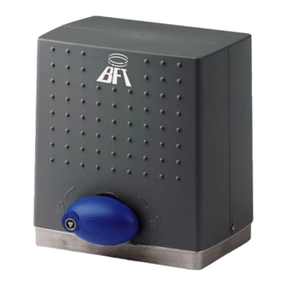
BFT
BFT Deimos Installation and user manual
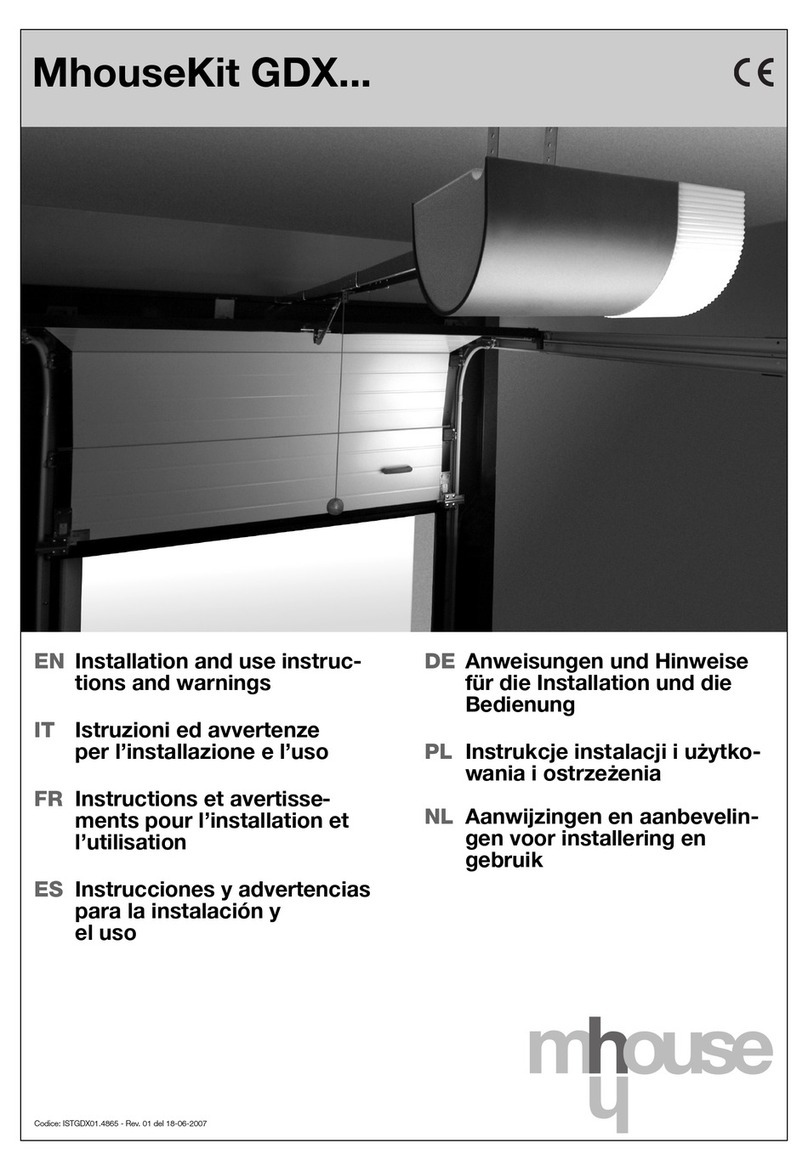
Mhouse
Mhouse GDX01 Installation and use manual

Motorline professional
Motorline professional KVM25 User's and installer's manual
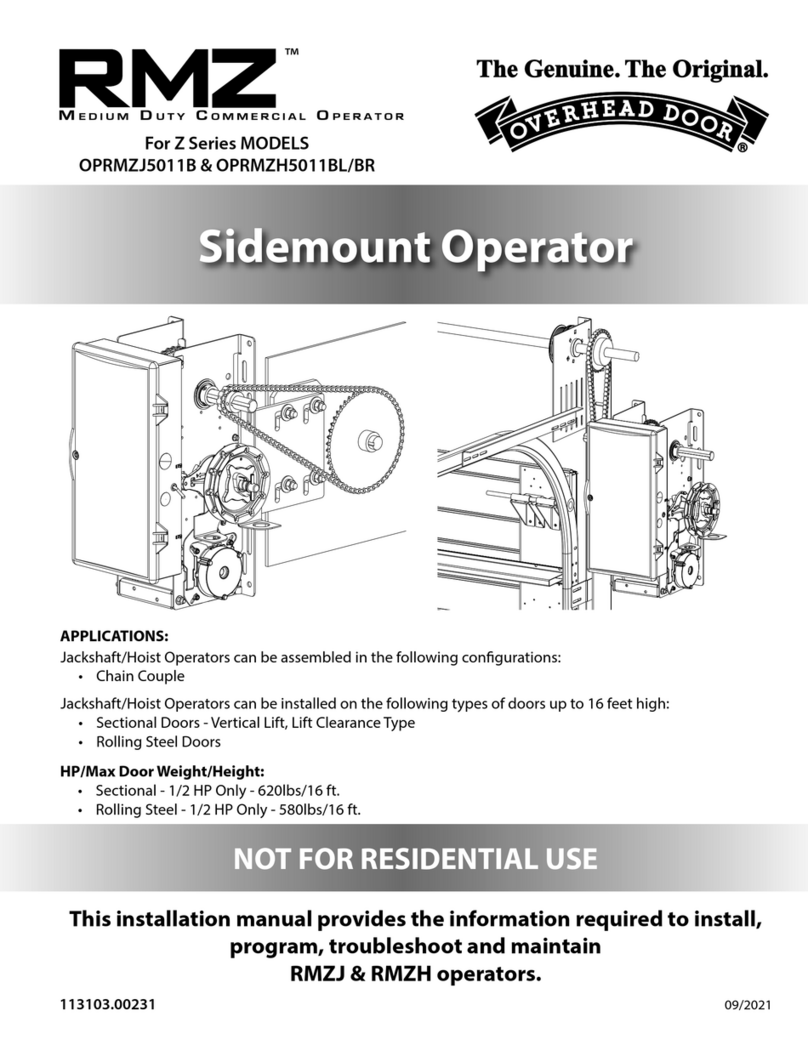
Genie
Genie RMZ Z Series manual
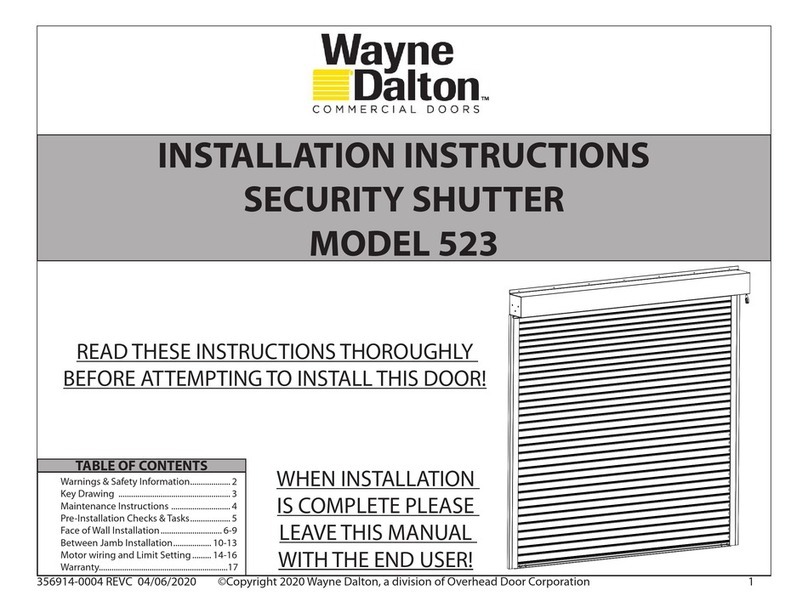
Wayne-Dalton
Wayne-Dalton 523 installation instructions
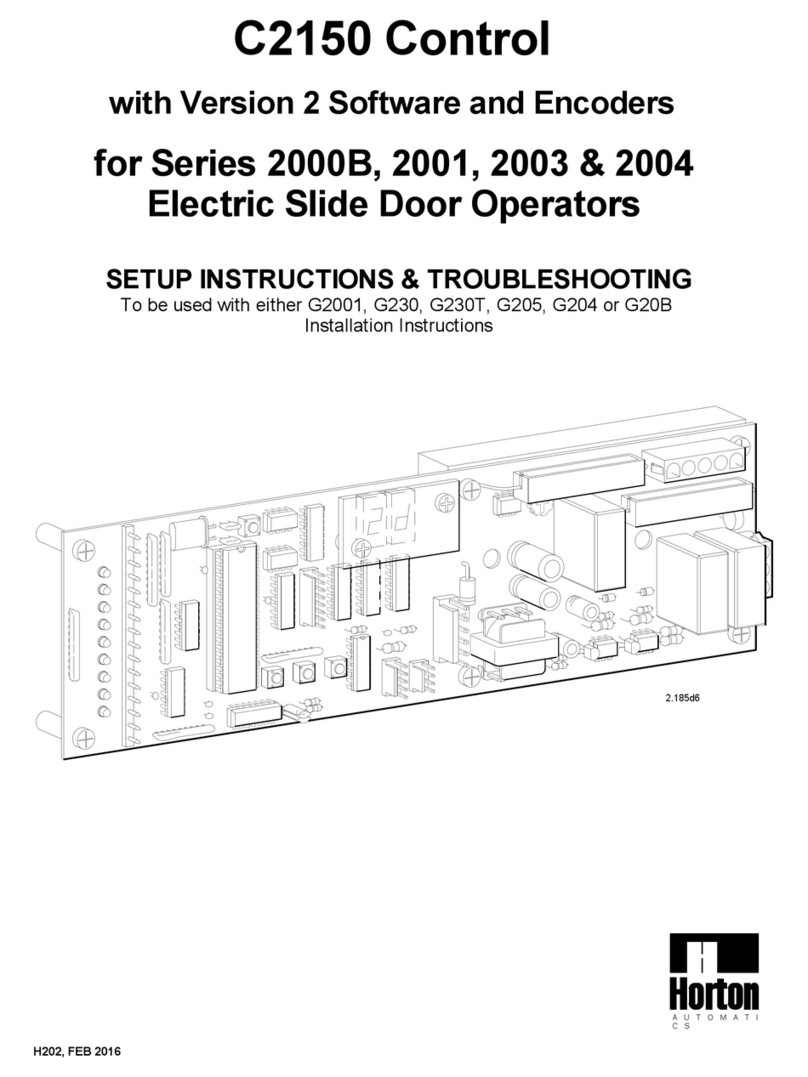
Horton
Horton 2000B Series SETUP INSTRUCTIONS & TROUBLESHOOTING
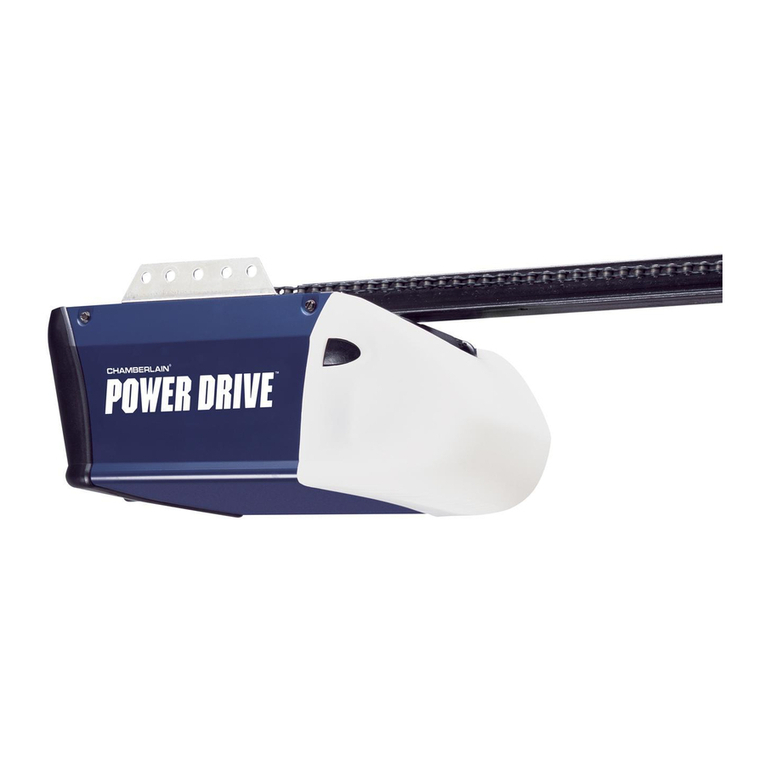
Chamberlain
Chamberlain Power Drive Assembly & installation manual
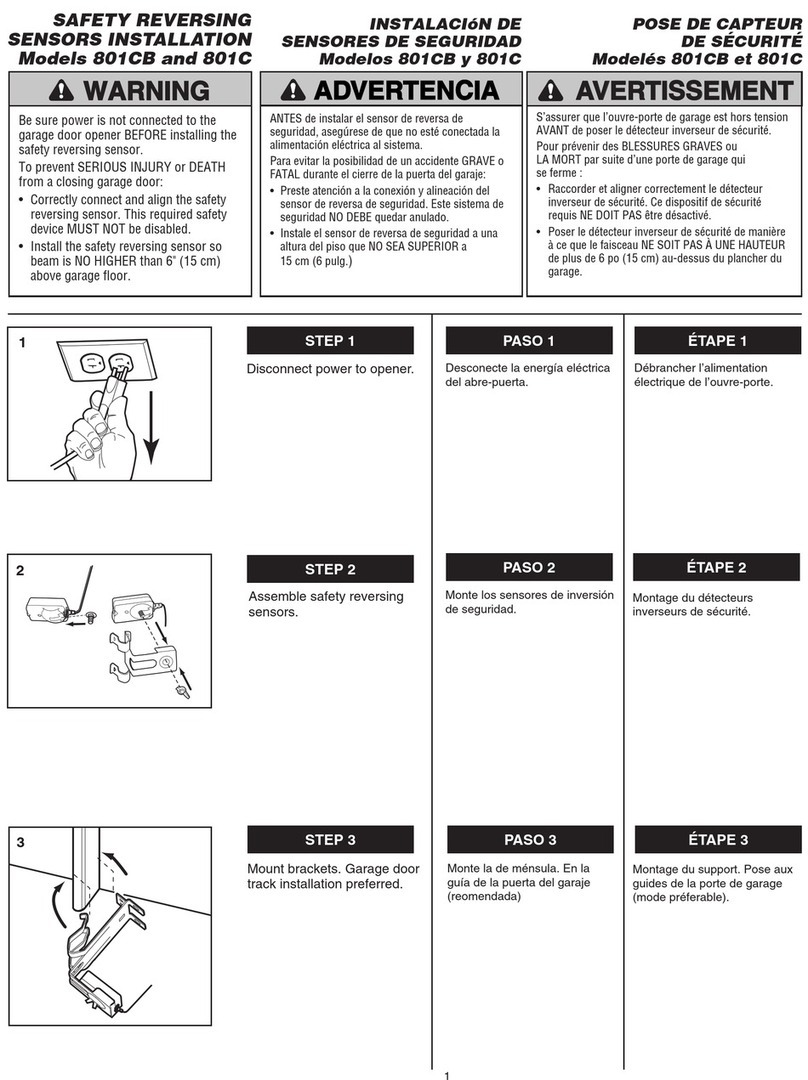
Chamberlain
Chamberlain 801C installation manual

Telcoma
Telcoma ASY Series Installation and operating instructions
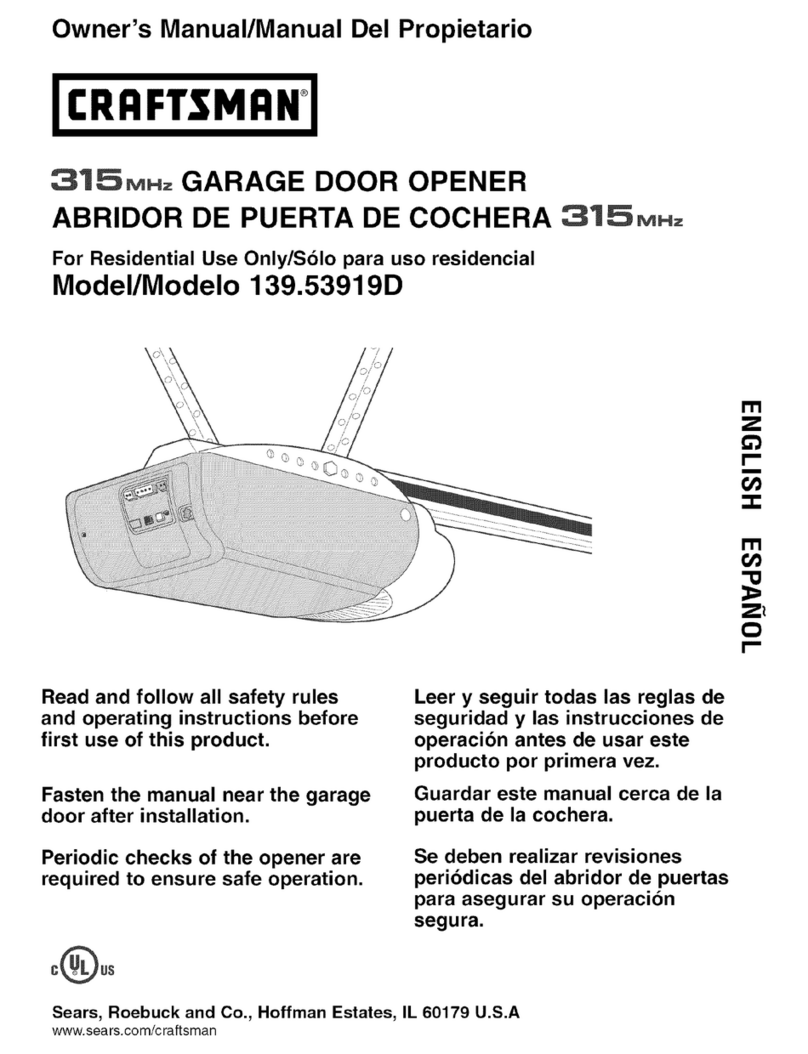
Craftsman
Craftsman 139.53919D owner's manual
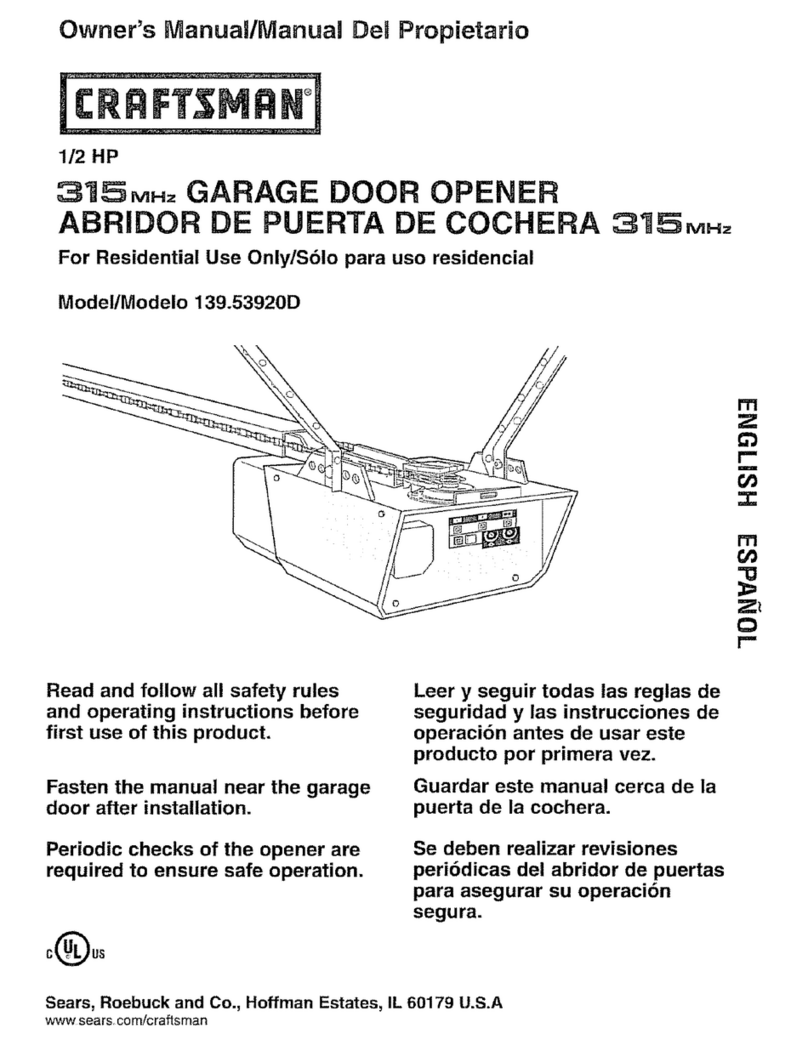
Craftsman
Craftsman 139.53920D owner's manual
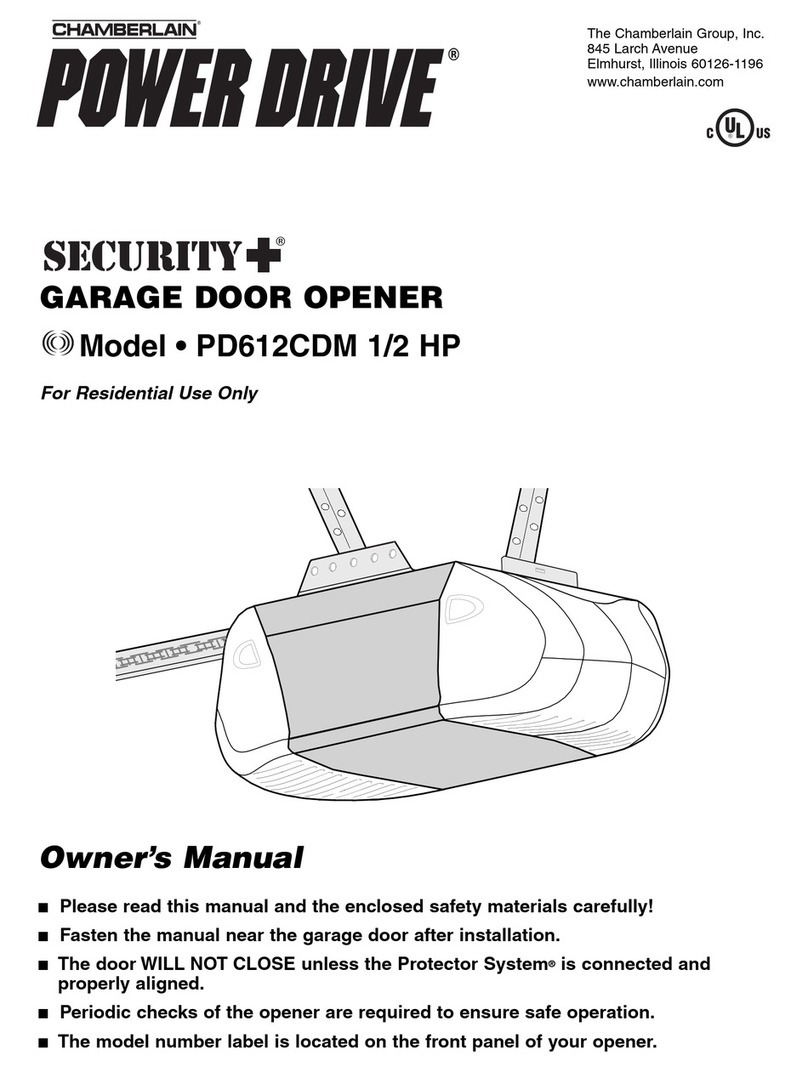
Chamberlain
Chamberlain Power Drive Security+ PD612CDM owner's manual
